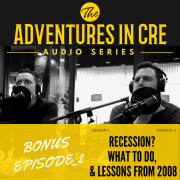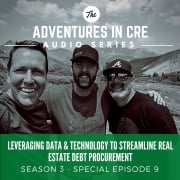How to Maximize Value for Tenants Featuring Justin Smith
This episode of the A.CRE Audio Series features Justin Smith, Senior Vice President at Lee & Associates and the author of Industrial Intelligence: The Executive’s Guide for Making Informed Commercial Real Estate Decisions. In this episode, he sits down with Michael, Spencer, and Sam to talk about how to maximize value for tenants.
A big thanks to Justin for making himself and his story available to our viewers!
How to Maximize Value for Tenants Featuring Justin Smith
Or Listen to this Episode
Resources from this Episode
Episode Transcript
Announcer (00:01):
Welcome to the Adventures in CRE Audio Series. Join Michael Belasco, and Spencer Burton as they pull back the curtain on everything commercial real estate, and introduce you to some of the top minds in the industry. If you want to take your skills to the next level and be part of a growing community of CRE professionals across the world, this is for you.
Sam Carlson (00:24):
All right. Hello and welcome back to the Adventures in CRE podcast. Today, we’ve got a great one for you. We’ve got the author, Justin Smith. Thanks for being with us here today, my friend.
Justin Smith (00:35):
Thank you for having me guys. I’m looking forward to it.
Sam Carlson (00:38):
Yes. So we’ve got maybe a broad introduction, but I think we’re really going to find a ton of value in this discussion. We’re talking about how to maximize the value with the right terms and the ideal tenants all from the tenant’s perspective. So this is a little bit of a different angle maybe than you might hear other places and to get us started, let’s kick it over to Spencer.
Spencer Burton (00:59):
Yeah. Sure. Sam, thanks. And Justin, really nice to have you on. So first as order of introduction, Justin Smith. Justin’s a Senior Vice President of Lee & Associates. A tenant representative also does some investment sales, so stop me if I’m getting anything wrong Justin. And one of the reasons we wanted to bring Justin on is he recently wrote a book entitled, Industrial Intelligence: The Executive’s Guide for Making Informed Commercial Real Estate Decisions.
Spencer Burton (01:30):
We’ll be sure to include a link to the book for those who are interested. And Justin brings this very interesting perspective as it relates to getting deals done with tenants. And he understands the tenant perspective as well as anyone in the industry, and at ACRE, we often take the perspective, the position of the owner. And so to hear how a tenant thinks about a lease negotiation, how a tenant thinks about its occupancy, maybe renewal, what drives their renewal decision, all those things I think will be valuable to this discussion. So thank you, Justin, for joining us.
Justin Smith (02:07):
Thank you for having me.
Spencer Burton (02:08):
Yeah. So I guess to kick us off, what made you decide to write a book? I know it’s somewhat off topic, but I’m genuinely curious. You’re out in industry, you’re doing deals and then you write a book. What was the impetus for that?
Justin Smith (02:23):
Yeah. Book writing in our world, we don’t see often in the brokerage world, but even in commercial real estate, I feel there are some great ones. Zeckendorf was one that I was on the show recently that we were talking to, that’s what’s on this picture behind me. That was an old school deal-making book of the East Coast and the United Nations building and how all that came together. For me, I had thought writing a book was more of, for the client and giving the client a resource that they can have, more of just when you think of knowing the process and then knowing what’s going on in industrial, because it’s easy to know about warehouses and of them. And for business owners, I feel like the market’s moving so fast and not just the real estate market, just with technology and the economy, there’s so many new developments, there’s so much new equipment.
Justin Smith (03:28):
And the news cycle is going so fast that I’ve found that a lot of people that are now running businesses that are manufacturers and distributors, there’s so much to spend your time on. So think of operations and finance or legal and HR and having a good product and continuing to innovate. So I feel like people that we work with are very smart and capable, but there’s no way they can possibly keep up with everything that’s going on in the industrial market. So I have found that having a place to put all the latest trends, because I feel like a lot of trends have been bubbling under the surface, but pre-COVID and during COVID, a lot of those accelerated. So it was a great time to level up and give everybody a primer of where are we at today in industrial? And what are the levers you can pull when you’re trying to make a change with your company and with your property?
Spencer Burton (04:30):
Yeah. That’s interesting. And even before we get into the tenants side, because we… And that’s the primary purpose of this episode, but here we are middle of 2021, we’ve just gone through one of the more disruptive periods in US history. A lot has changed, and as to your point, many of the pre-COVID trends are simply accelerated by COVID. So rather than talking about where we are today versus a year, a year from now, I’d be interested in your perspective five years from now, how does industrial look relative to today? How has it changed? Has it improved? What are your thoughts on that?
Justin Smith (05:08):
Yeah, I think one of the most interesting developments that I’m paying attention to is how autonomous driving is coming into the trucking world and how that will change, how product comes out of the ports and how it’s distributed to fulfillment centers and distribution centers and last mile delivery and what role it plays, if any. And I have a conversation going with Waymo, which is Google’s autonomous driving, where we’re exploring that a little bit. But when you think back on Tesla and self-driving mode and electric cars and what we’ve all experienced in the last five years with that, has everybody here been impacted by that? I would imagine most people in some way, you’ve heard about it. Once you’ve had the experience of driving one, you’ve been blown away by it.
Justin Smith (06:06):
And then when you think of what that could look like soon, it’s interesting to apply that to transportation and warehousing. And one way that would change things is in where you need your building. So think about all things supply chain. So an example is I’m near the port of LA, Los Angeles and Long Beach, and everybody keeps moving further East where there’s land for bigger buildings and for lower overhead. And then we have five hours further east is Las Vegas. Las Vegas has different regulations, different taxes, lower costs. Could you imagine Las Vegas being where you keep all of your product instead of in Southern California because the trucking would change?
Justin Smith (07:00):
That’s one of the things that I feel is interesting that’s on the horizon and that’s probably what’s furthest out on the horizon that’s very interesting. One step closer is robots in the warehouse, and what does that mean for companies and their ability to grow and their ability to move product faster to meet all of our pressing demands for shipping that same day or shipping that’s in the morning or that’s one day or two day. All of those are interesting industrial developments that are out there that we’re all paying attention to.
Spencer Burton (07:37):
And then Michael, I’ll let it, kick it over to you, but if you think about it, every one of these are decisions that tenants make. Users of space. As tenants business change, their space needs change. Where that space is, the size of the space, the format of the space, the height of the ceilings, how many docks they have. All of that changes based on the needs of the tenant. Over the last 12 months, how have tenants’ needs changed, and how is that influencing their space requirements?
Justin Smith (08:14):
It’s the opposite of office. So if office was, we all go into our living room and our home office for a period of time, and we experiment with the work from home and distributed workforce, on a great scale. And now we’re figuring out what components of that remain and which parts do you bring people back in and what does the office space look like now? That was companies needing less. In industrial, I have found that’s led to tenants needing more and companies needing more. And you cannot work from home with a forklift and a pallet jack and big rig. Those are things that just that’s inherent in that product type. And then the flow of goods was disrupted with, we have at most of the ports there’s been a lot of disruption of ships that can’t get through the port.
Justin Smith (09:15):
And then when we had March and April of last year, you had retailers closing. So you had product that was going to go to the store, stop. And if you had Nordstrom’s was closed, the Macy’s was closed, everything but the grocery store was closed, where did all that stuff go? That went into warehouses, it went into storage, and that was the short-term inventory supply shock. But then in the future, what can you do to insulate yourself from the next shock? You might hold more inventory. So you may want to be closer to your customer or to where the product is coming from or to the port itself. So I’ve found the majority of the activity led to more space being taken and that dovetails into just the big trends in e-commerce, and those types of developments.
Michael Belasco (10:14):
Great. All right. So I want to get in a little bit, I guess, closer to the deal-making between tenants and landlords, because we want to hear more. There are certain perspectives where you look at from the owner’s side, and we’re paying attention to value in getting these long-term leases in place. All types of variables that we look at and trade-offs. And there are things on our side that we value more than others. And you being on the tenant side, it’s good to hear how, what the inside conversations are when you’re talking to your tenants and you’re approaching an owner, and what are some of the bigger… And this could be evolving because this is such a fast-evolving industry.
Michael Belasco (10:55):
What are some of the major sticking points or important things that are harder for tenants to give on, that you could point out to, and some stuff, when you’re thinking of negotiation and strategizing, what might an owner be able to give that might be deemed more important to a tenant? So I’m curious to get into that world, open the curtain a little bit outside of the negotiation table and just hear more about the tenant’s perspective.
Justin Smith (11:22):
Yeah. It’s a very relevant and rent growth is the first top in bold, size 50 topic. So rent growth was, in your model, do you put 3% annual rent growth? Is that the generally accepted inflation that we put for that? That’s what’s in lease documents, the majority of them, you do a five-year lease, you have 3% bumps, and that’s the deal. Rent has started to take a trend where… And this is kind of a long-term trend of increasing on average 7% over the last eight years. So that means that if you have this 3% inflator going and the market’s got the 7% inflator going, you true up every five, seven or 10 years. And so when you do, what does that mean? That means you’ve got 12 to 40% to catch up. And so when you catch up, that’s overhead on your P&L. That’s your profit, that just was taken off the table that you then have to fight to get back onto the table.
Justin Smith (12:35):
So I feel that’s one of the one challenges that reaches all industrial tenants. And for landlords, they have been figuring out, a lease roll is a good thing now. You used to think lease roll was bad because you had the percentage chance your tenant was going to renew was never high enough. And when they did renew, you had all these CapEx expenditures and leasing commissions and just regular TIs, much less specialized TI. That’s weird to say, it doesn’t feel right, but that it is good because you can buy a building now with a tenant in it and be happy if they move out because you can now mark it to market. And that’s your time to shine as an investor to make sense of low cap rates.
Michael Belasco (13:40):
What you’re saying is a supply demand imbalance where demand is far exceeding supply and so therefore it translates to a landlord advantage it sounds like, because if you’re not going to pay up, then see you later and it’s okay. So in that regard, on the macro trend and what you were talking about earlier about, “Well, hey, Las Vegas has better tax and maybe it’s better rent incentives too.” Have rent costs come into play now? Has it become raised so much that now, it’s impacting logistical operations? Are industrial companies looking further East, in your example, just because of the cost [inaudible 00:14:23] rent. Has that gotten to such a level where that becomes a part of the decision-making process in terms of actually locating your building or not yet? Where are you seeing that landing?
Justin Smith (14:37):
Well, I’ve seen 400 or 500 headlines of companies leaving So Cal and going to Plano, Texas. That would be the Wall Street Journal version of what is happening. But I think without a doubt, the amount of rent has gotten high enough where it’s companies are wondering, how can it go up more? And if it does, what can I do? And I think to your point, it’s making people make decisions that’s different than they ordinarily would have made of, “Yes, of course we’ll continue the status quo for another five years.” Now, it’s if the status quo, then what? And then what, it can be smaller? It can be a different geographic area, or it can be a different arrangement altogether. Like “We won’t have a warehouse we’ll just rely on third-party logistics companies to handle our inventory or trucking.”
Justin Smith (15:39):
So it’s definitely creating increased challenges for CEOs and CFOs to figure out how, what can we do about this? And there is not much you can do with that one line item, rent. That amount is, it is hard to deal with. And so in the book, part of the frame I take for the tenants perspective is to change the frame of what’s that space value to you and your operation? And that doesn’t make the landlord then say, “No, I won’t let you vacate.” And mark to market and get some new tenant in there right, you still have to work within the confines of the market dynamic. But I think for owners, as I was going through the book and thinking through this challenge, you really got to get into what’s in your business and get into the heart of each segment of your business and what you really need, what you’re really forecasting.
Justin Smith (16:39):
And then you can come back and say, “Okay, rent has gone up.” But we now understand what its value is to us. It’s almost like having a model for the tenant for their own decision-making to put everything into context and perspective.
Michael Belasco (16:56):
Yeah. I almost see it like a bubble. There’s this cost and you push on one and, or a balloon is probably better and then you move your logistics. Okay. Your rent’s gone down, but actually, how does that impact transportation costs? And I can imagine if I was one of these industrial comps on the tenant side, I’d be doing all this type of analysis. It’s fascinating to think through, especially if it’s moving so quickly.
Justin Smith (17:23):
And labor right, if you went to a Reno, Nevada, are there enough people that do what it is you do that you could hire? Or does that change if you’re going to Boise, Idaho versus an area based on either university’s, skilled labor, unskilled, union, non-union. I feel like those are topics for when you are the investor. Investors are starting to pay more attention to those dynamics because they recognize that those play on the tenants dynamics and the tenant is ultimately who they’ll be looking to attract to their property.
Spencer Burton (18:02):
So let me ask you something, as tenants are considering locations, if you put yourself in the mind of the CEO or the COO, and they’re choosing a location, what would be the top three considerations that they’re making in choosing a location? And we’re speaking, I guess, industrial tenants here, yeah.
Justin Smith (18:26):
Yeah, I think we have covered them. So one is a property, one is transportation and the last one is the labor. And I think another fact that people really think about is can… What’s a new location? That usually means there’s a new customer, new product or a new relationship, or you’ve won a new piece of business. So oftentimes when you go into a new location, you have the opportunity to acquire a company that’s already in that location that already has the operation up and running for you. So that might be a sneaky fourth thing to think about, are there any other competitors or any other partners that are there that we could purchase or that we could collaborate with in addition to property, transportation and labor?
Spencer Burton (19:18):
Yeah, so when you say property, are we speaking about the physical characteristics of the building?
Justin Smith (19:25):
Yeah. I mean, property first, just is there suitable property available? And if so, how many of them are there and of those, how many are a realistic fit? And then the timing when they become available? And then any incentives you can get. What’s the incentive structure there? And so in new areas, sometimes it’s just leasing a building, but for some companies, they prefer to own. And then some people that are leaving California and going to lower-cost markets, there’s land available. So is there land to build and with developers that have, that own land. And are there any incentives from the city or the County or the state for that land, for construction of the building, or even incentives for labor, for hiring or for equipment. So depending on who you are and where you’re at in the country and what kind of expansion you’re going into, those are the main segments between lease, buy, and build.
Spencer Burton (20:34):
Sure. So let me push a little harder then. So we have property, transportation and workforce. But transportation it really is I would assume, stop me if I’m wrong ingress-egress, proximity maybe to two suppliers or to customers, proximity to ports or to rail or otherwise. And I know it varies by company, but if you were to rank those in general, one through three, which would be the most important, which would be second, and which would be third?
Justin Smith (21:10):
Components of the property or of transportation, or between property transportation and labor?
Spencer Burton (21:16):
Yeah. I mean, importance to the tenant, right. So from the landlord’s perspective, it’s like, what does my tenant really need? Do they need locations that are close to the workforce? Do they need locations that have good ingress-egress and transportation, or, is it more about the property? What is the most important aspect to the tenant?
Justin Smith (21:35):
Yeah. On a small to medium-sized scale, where does the CEO live? He’s got to go to work every day. He’s got to have the vision that he’s communicating to his team, he has to be in touch with them. That’s where our one-man band, small operations… Or even just the corporate headquarters right, if you don’t have multiple buildings throughout the country, that’s the first one. But I think after that really it’s the customer right, so without customers, you’re not in business. So where are your products coming from for the customer and how can you serve them in the way that they need service? So that might be the amount of product you can get to them, it may be the time that you can get it, shipping times. I think that’s the next, most important criteria that people look at.
Spencer Burton (22:34):
Yeah. It’s interesting you say that. So I spent a while pursuing industrial investments in Mexico, and Tijuana has a really interesting market. A high barrier to entry, there’s minimal land, it’s a great industrial market, Tijuana is. But there is a sub market in Tijuana that the building stock is not great. It’s because the topography has issues and the rents are higher, but it’s a very popular sub market, and why? Because it’s close to where the plant managers live, and often it’s about convenience as much as anything for your people so that’s fascinating.
Spencer Burton (23:13):
Let me ask you another one then. Sorry, Michael, if I’m on stepping on your toes, I know you have some questions here, this is fascinating. How does the tenant expect to be treated by the landlord? And I know that seems like a softball question, but do they want a landlord who just leaves them alone? Do they want a landlord that’s hands-on? How does the tenant want the landlord to treat them?
Justin Smith (23:38):
Yeah, it’s evolving too, as landlords become more institutional right, so I find that, that’s a one part of the narrative, but increasingly as a partner, yeah. And I say that because when there is less inventory available and you’re growing, who can you turn to for more inventory? Your landlord. They may be building something, they may have other… In their rent roll, they may have expiring leases that they can make you aware of that are not publicly known. So today, practical figuring out how you work within a low inventory environment. But I feel like increasingly it’s more professional where we used to have a more of a cowboy environment where a lot of the developers were just individuals and a lot of the ownerships were old families, and you had more personality.
Justin Smith (24:44):
There’s still plenty of room for personality in our business, but I feel like institutions not only are doing the million square footers and the 500,000 footers. Like the biggest of the big we’ll buy a 40,000 foot building because they’re having a hard time finding inventory to purchase. So we’re finding that we’re dealing with the larger institutions, even in the small space, even in like a thousand square feet, isn’t necessarily owned by mom and pop anymore. It might be owned by Reits Or by Rexford or by another institutional group. And so what I take out of that, Prologis is a great example. The landlords provide services for tenants. So you’d never see that in industrial before, where if you need to buy new equipment, they know all the equipment makers, and they have some arrangement with them that can help make it cheaper or faster or easier to find.
Justin Smith (25:46):
And that could be the same with when COVID came of having sanitation and to increase your janitorial and any supplies you would need, they would help bundle that kind of stuff for their tenants. And that’s something that was unheard of for a long period of time. Of having landlords trying to get into the thought process of who is my tenant, what do they need? What are some of their challenges and how can I help them? And that is an interesting dynamic, right? That I find that Prologis maybe led the charge with that, and then how many other landlords are following suit? And I think that really depends on what kind of landlord you are? How long you’re planning on holding a… Are you a public company and you’re focused purely on land lording or are you a Reit? Or are you a private fund that has… Each will have its own type of personality, but on the big broad brush theme, I find being more of a partner, understanding more of the other’s perspective that, that’s really flowing into our world a lot more.
Michael Belasco (26:57):
Fascinating, the more we talk and the more you really get into it, it becomes very sophisticated. There’s so many level levers that you can pull here. It’s not just about a building and a location, it’s about transportation costs. It’s about understanding labor in any given area, what kind of services you could provide, so there’s all these. I’m thinking about it from the investor owner side, hearing the tenants’ needs. And you look at industrial, it’s like, what’s the clear heights of the ceiling? What’s ingress-egress? How many bays are there, those types of things on the building.
Michael Belasco (27:34):
But there’s just so much additional that you could be adding as a value proposition. Maybe your building’s not a perfect fit, however, here’s some of the offerings that we have as a landlord here. Here’s why it’s good to locate here. So it’s really good to hear all of these different and additional insights to be considering as you’re valuing and looking [inaudible 00:27:56].
Spencer Burton (27:57):
Yeah. I was going to say, the big takeaway from this piece to me is look right now, it’s a landlords market. It won’t always be a landlord’s market. And those landlords who treat their tenants like customers and provide those tenants with what they need and build a long-term relationship as you said Justin, partners, when it becomes a tenants market again, those landlords will continue to thrive because they provide the environment that the tenants need to succeed. And by the way, if you’re a mom and pop, you need to start acting like an institution. It’s time to up your game because it’s, you’ve got stiff competition, institutions they know the business and they do it well, and it’s totally possible. But that’s the other takeaway.
Michael Belasco (28:48):
Yeah. That’s great. So I want to shift back a little bit and go back to your book, Industrial Intelligence. So it’s funny when you take on an exercise such as that, it becomes a lot more academic, so I wanted to ask you two questions here. The first is, did you find that you actually learned a tremendous amount about your industry by way of just writing that book? Did you learn a lot just through the process? And the second piece to that is what are some… If you could share maybe one or two major takeaways that you might have discovered? You might say you did and you knew everything, but I’m just curious to hear how the process of writing a book impacted your professional abilities and knowledge? And then also, if you could share some, give us some little nuggets that are in the book that you found to be most valuable, it’d be great to hear.
Justin Smith (29:40):
Yeah, I became intimately aware of where my knowledge ends because you’re trying to put that out there, right. You’re trying to really help as best you can, and inevitably you can’t belong in all topics, in every segment. So one great experience for me through the book was vendors. Brokers oftentimes we’ll provide references and referrals for CEOs, and they’ll say, “Hey, I need to get new racking. Hey, we’re looking at new furniture. Hey, we need to build out something construction-wise. Hey, we want to see if we are in Reno instead of Vegas, what that looks like? How do we model that?” And so those are people I’m used to recommending, but not that I know… I’m not running the supply chain model, I’m working with the supply chain modeling partner of mine, and then we are working together on the assumptions that go into that model.
Justin Smith (30:42):
So what I tried to do was expand upon what I knew for material handling, for supply chain and network analysis, for site selection and negotiating incentives, architecture and space planning, commercial contractors and construction. And I tried to get out as far as I knew, and then bring it to a couple of trusted partners and say, “Hey guys, let’s expand this. Let’s talk. What else is important? What am I missing? What did I hit on but I’m not really explaining it properly.” And so that was really fun to extend my network that way, in terms of additional resources that we can bring to clients and then to think, can we stretch? So I find another fun part was that, what would we like to know that we don’t yet know? What are topics that are on the cusp? Like Waymo and autonomous trucking or with, for me it was warehouse automation and robotics.
Justin Smith (31:48):
So I’d say that was there to answer your second part. I knew of it, I’d heard it, I’ve seen some systems in different warehouses, but it was an opportunity to speak with a lot of those people that are building the systems, and to think through, when do you automate your warehouse? What’s the first thing you do when you’re automating it? What products can you automate it with, and which ones can’t you? And is there automation coming that’s outside the warehouse? Or how does that tie into computers and software and your IT? And digging into all that was, that was one where rarely are clients coming to me and saying, “Hey, I’m looking to automate, what machines should I buy?” That’s not where I excel in my expertise, but it has real estate implications, right.
Justin Smith (32:45):
So if you are running an operation and you can now rack with a different system, because you have these pallet runners that go underneath the pallets, pick them up and move them to you. You can have a more dense warehouse with own isles. So if you don’t have isle space, then your cubic space changes of how much you need. And that might change what kind of building you [inaudible 00:33:08] or how tall you go into? Or what size? There’s real scale issues there. And so that was interesting to expand on that area where I felt like I was weak and where this could be an opportunity to learn something new and then immediately share it and have that be something that will increasingly be a component of the dialogue with executives moving forward, as they decide where they go and what they need and how we go about putting that together?
Sam Carlson (33:42):
That’s awesome. Yeah. Before long, we’re going to see drones, delivering our packages and all that kind of stuff, autonomous trucks and all that kind of stuff. That’s a pretty, pretty wild time. So, Justin, this has been absolutely fascinating. As a person who’s learning parts of the business, normally what I am learning again is from the underwriting side, from the investor side. And like you said, anything in business, 100%, anything in business can be improved when you learn to see the transaction through the other person’s eyes. So this has been absolutely phenomenal, thank you for being here. And as far as links to you, people connecting with you, where’s the best place to do that?
Justin Smith (34:30):
LinkedIn is great. Yeah. We brokers are easy to find and easy to reach.
Sam Carlson (34:36):
That’s right.
Justin Smith (34:36):
So it doesn’t take much, but that’s a great place to go.
Sam Carlson (34:40):
That’s great. And we will have links to the book and to your social media in the show notes of the podcast here, so thanks for being with us. And to listeners thanks for tuning in, and we’ll see you on the next day episode.
Announcer (34:52):
Thanks for tuning into this episode of the Adventures in CRE Audio Series. For show notes and additional resources, head over to www.adventuresincre.com/audioseries. Would you like to learn real estate financial modeling in a matter of weeks and do it with zero guesswork? If so, the ACRE accelerator is for you. The accelerator is a step-by-step case-based program designed to teach you exactly what you need to know, and in the order you need to know it. So you can gain both the knowledge and experience to take your career to the next level. To see if the accelerator is right for you, go to www.adventuresincre.com/accelerator.








